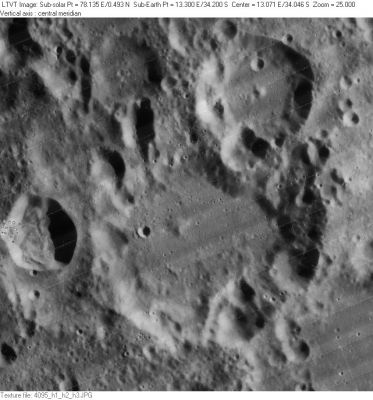Gemma Frisius
Contents
Gemma Frisius
|
Lat: 34.2°S, Long: 13.3°E, Diam: 87 km, Depth: 5.16 km, Rükl: 66 |
LO-IV-095H Gemma Frisius is in the center. The 46-km crater to its northeast is Goodacre. Many named lettered craters associated with both are also visible. The most prominent is probably the deeply-shadowed 28-km Gemma Frisius D, just outside the west rim of Gemma Frisius. Part of the northwest floor of 68-km Gemma Frisius A is visible in the lower right corner.
Images
LPOD Photo Gallery Lunar Orbiter Images Apollo Images
Maps
(LAC zone 113A1) LAC map Geologic map
Description
Description: Elger
(IAU Directions) GEMMA FRISIUS.--A great composite walled-plain, 80 miles or more in length from N. to S., with a wall rising at one place nearly 14,000 feet above the floor. It is broken on the N. by two fine ring-plains, each about 20 miles in diameter, and on the W. by a third open to the W. There is a central mountain, and several small craters on the floor, especially on the E. side.
Description: Wikipedia
Additional Information
- Depth data from Kurt Fisher database
- Westfall, 2000: 5.16 km
Viscardy, 1985: 5.2 km
Cherrington, 1969: 5.21 km
- Westfall, 2000: 5.16 km
- Central peak height
- 0.6 km Sekiguchi, 1972. - fatastronomer
- Satellite crater Gemma Frisius M is on the ALPO list of bright ray craters.
- Satellite craters Gemma Frisius Ea, Eb, and K are on the ALPO list of banded craters
Nomenclature
- Named for Gemma Frisius (December 9, 1508 - May 25, 1555), a mathematician, cartographer and instrument maker. He created important globes, improved the mathematical instruments of his day and applied mathematics in new ways to surveying and navigation. He became noted for the quality and accuracy of his instruments, which were praised by Tycho Brahe, among others. In 1533, he described for the first time the method of triangulation still used today in surveying. Frisius created or improved many instruments, including the cross-staff, the astrolabe and the astronomical rings.
- According to Whitaker (p. 212), this name was used for the same feature by Riccioli.
- The row of craters which connect Gemma Frisius and Rabbi Levi (east of Gemma Frisius) was once known as The Link. This name (nickname) appeared on a moonmap which was included in the LPOD of February 11, 2004.
LPOD Articles
Bibliography
